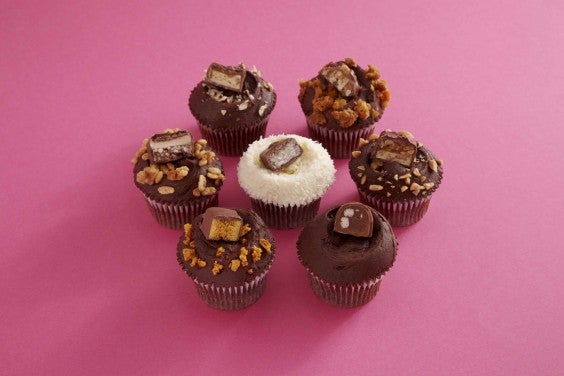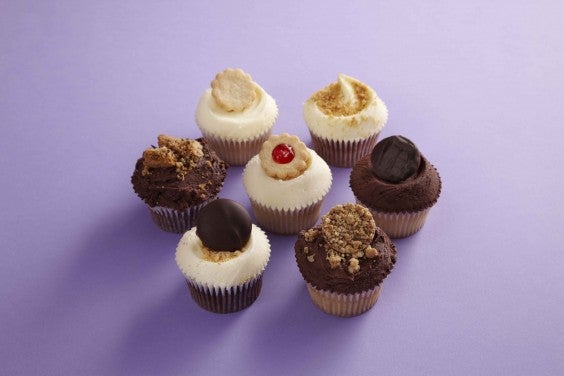
Where did the cupcake craze come from? As an American bakery in London, it’s our duty to share a little history behind our all-time favourite bake: the cupcake.
In 2004 we brought the cupcake to London in a big way when we opened our first bakery on Portobello Road.
Our first customers to our bakeries had no clue what Red Velvet cupcakes were (deep red vanilla sponge with a hint of cocoa and cream cheese frosting) and there were many questions surrounding whether a cupcake and a fairy cake and a muffin were the same thing.
It was apparent that Londoners were familiar with fairy cakes and it took a little time for them to adjust to the bigger sponges and generous frostings. But they soon realised bigger was better and the cupcake was here to stay.

While cake itself in some form or another has been around since ancient times, cupcakes first came about in America.
It is thought that the first ever reference to ‘a cake to be baked in small cups’, rather than as a layer cake, was in Amelia Simmons’ ‘American Cookery’ in 1796. The first reference to the word ‘cupcake’ is said to be from a 19th century American author named Eliza Leslie in her cookbook ‘Receipts’.
It’s possible that ‘cupcakes’ were also a reference to measuring techniques, with several cakes distinguishable by name by their measurements to make them easy to remember by volume, such as pound cakes.

There is no single inventor of the cupcake. The history of the cupcake isn’t entirely clear as most recipes were developed in home kitchens and passed down through families and friends, with adaptations often made out of ease or convenience.
It is likely that the small size, dainty appearance and individual portioning made the cupcake an easy alternative to the rituals of slicing a whole cake and serving with forks. The heat of an oven was also an expense and reducing the size of the cakes to be baked was economical.
Furthermore, as we know from baking cupcakes with our little ones, their size and shape is great for children and for sharing, making them a handy dessert for birthday parties and celebrations. And let’s face it: no one likes to share cake!

As we know from our many-shaped novelty cake tins out there, cake mixture can be baked into virtually any shape. It’s likely that little teacups, ceramic cups or ramekins, rather than a specially shaped tin or paper cases, became the first foray into cup-shaped cakes.
Like with many foods, advances in food technology allowed cakes to travel. Commercial shop-bought cupcakes appeared around 1919 when American bakery company Hostess introduced a single-portioned ‘CupCake’ as a snack cake.
The first ever cupcake-only bakery opened in America and it wasn’t long after that The Hummingbird Bakery brought cupcakes to London, selling out on the first day of opening. And we’ve been baking them ever since!

Cupcake FAQs
How can I frost my cupcakes with a palette knife?
Watch our video here to find out how to frost cupcakes, Hummingbird Bakery style:
What is your bestselling cupcake?
Our bestselling cupcake is the Red Velvet followed closely by Black Bottom, but our newer flavours of Salted Caramel, Nutella and Biscoff are all challengers.
Are any of your cupcakes suitable for vegans?
We don't currently make any vegan products in our bakeries.
Are any of your cupcakes suitable for coeliacs?
We bake Made Without cupcakes and cakes in kitchens that handle gluten-containing ingredients. Our Red Velvet cakes contain distilled white vinegar which is fermented from barley. We have consulted with the Coeliac Society who have told us that if this vinegar is used in a food product then we must list the word ‘barley’ in the ingredients list in line with EU-wide allergen labeling law. However, as distilled white vinegar is made using a fermentation process, this means that the amount of barley, and therefore gluten, in the end product is extremely small and is well below a level which is safe for people with coeliac disease. This level is made even lower as the vinegar is used in very small amounts in the Red Velvet batter. The data sheet for the particular type of vinegar that we use confirms that no traces of gluten have been detected during tests. Please visit the Coeliac Society’s website for further information.

How long will my cupcakes keep for?
Eat your cupcakes within 24 hours, or as soon as you can, for that fresh-baked flavour. We don’t recommend that you refrigerate cupcakes. However, if you do refrigerate them, allow time out of the fridge before serving for the best possible flavour.
What happens to unsold cupcakes in your bakeries?
We bake our cupcakes fresh on the day and sell them on same day to give you the best tasting cupcake in town. Any leftover cupcakes that aren’t sold are offered to charities for collection at the end of the day.
Where can I find your cupcake recipes?
All our cookbooks contain cupcake recipes, they are a speciality at The Hummingbird Bakery and we love their versatility as they have endless flavour options. We hope you’ll try some of our various cupcake recipes in our cookbooks.
How do I convert a cake recipe into cupcakes?
Visit our sponge conversions page for tips.
And what is the difference between a cupcake and a fairy cake and a muffin?
Sponge sizes and frostings separate these individual cakes. Cupcakes are bigger than fairy cakes and smaller than muffins in terms of the size of the sponge.
Muffins come with or without glazes, while cupcakes and fairy cakes always have some sort of topping.
Classic American cupcakes like the ones we bake are generous on buttercream, cream cheese and custard frostings, whereas fairy cakes will sometimes only have a small amount of buttercream and jam or icing glaze on top.

